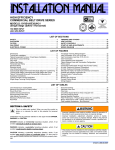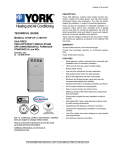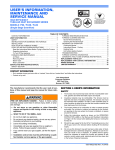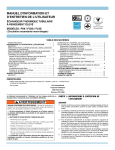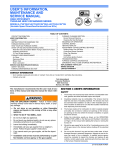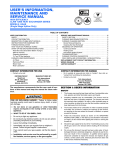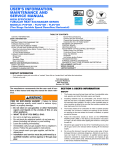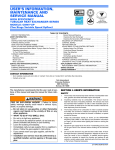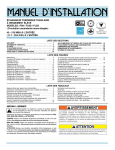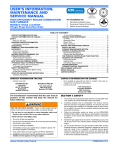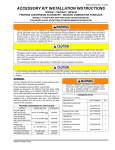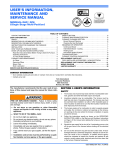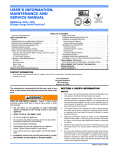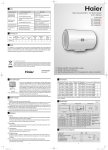Download York Furnace GY8S160E30UH21 User's Manual
Transcript
USER’S INFORMATION, MAINTENANCE AND SERVICE MANUAL HIGH EFFICIENCY COMMERCIAL BELT DRIVE SERIES MODELS: GY8S160E30UH21 (Single Stage Upflow /Horizontal) TABLE OF CONTENTS CONTACT INFORMATION . . . . . . . . . . . . . . . . . . . . . . . . . . . . . . . 1 USER’S INFORMATION . . . . . . . . . . . . . . . . . . . . . . . . . . . . . . . . . . . 1 SAFETY . . . . . . . . . . . . . . . . . . . . . . . . . . . . . . . . . . . . . . . . . . . . . . 1 INSTRUCTIONS FOR EXAMINING THE FURNACE INSTALLATION . . . . . . . . . . . . . . . . . . . . . . . . . . . . . . . 2 HOW YOUR GAS FURNACE WORKS . . . . . . . . . . . . . . . . . . . . . . 3 START-UP AND SHUTDOWN INSTRUCTIONS . . . . . . . . . . . . . . . 3 Read the Instructions Below Before Trying to Start the Furnace . . 3 Operating Instructions: . . . . . . . . . . . . . . . . . . . . . . . . . . . . . . . . . . 3 To Turn Off the Appliance: . . . . . . . . . . . . . . . . . . . . . . . . . . . . . . . 3 FURNACE USER MAINTENANCE . . . . . . . . . . . . . . . . . . . . . . . . . 4 Air Filters . . . . . . . . . . . . . . . . . . . . . . . . . . . . . . . . . . . . . . . . . . . . 4 Removing the Air Filters . . . . . . . . . . . . . . . . . . . . . . . . . . . . . . . . 4 Motor Lubrication . . . . . . . . . . . . . . . . . . . . . . . . . . . . . . . . . . . . . . 5 SERVICE AND MAINTENANCE MANUAL . . . . . . . . . . . . . . . . . . . . 5 SAFETY SECTION . . . . . . . . . . . . . . . . . . . . . . . . . . . . . . . . . . . . . . 5 FURNACE MAINTENANCE SECTION . . . . . . . . . . . . . . . . . . . . . . 5 FURNACE CLEANING SECTION . . . . . . . . . . . . . . . . . . . . . . . . . . .6 Burner Removal/Cleaning . . . . . . . . . . . . . . . . . . . . . . . . . . . . . . .6 Cleaning the Heat Exchanger . . . . . . . . . . . . . . . . . . . . . . . . . . . .6 SEQUENCE OF OPERATION . . . . . . . . . . . . . . . . . . . . . . . . . . . . .6 Continuous Blower . . . . . . . . . . . . . . . . . . . . . . . . . . . . . . . . . . . . .6 Intermittent Blower . . . . . . . . . . . . . . . . . . . . . . . . . . . . . . . . . . . . .6 Heating Cycle . . . . . . . . . . . . . . . . . . . . . . . . . . . . . . . . . . . . . . . . .6 Hot Surface Ignition System . . . . . . . . . . . . . . . . . . . . . . . . . . . . . .7 TROUBLESHOOTING . . . . . . . . . . . . . . . . . . . . . . . . . . . . . . . . . . .7 FURNACE CONTROL DIAGNOSTICS . . . . . . . . . . . . . . . . . . . . . . .7 DIAGNOSTIC FAULT CODE STORAGE AND RETRIEVAL . . . . . .8 REPLACEMENT PARTS LIST . . . . . . . . . . . . . . . . . . . . . . . . . . . . . .9 FIELD INSTALLED ACCESSORIES - NON-ELECTRICAL . . . . . .10 REPLACEMENT PART CONTACT INFORMATION . . . . . . . . . . . . .10 WIRING DIAGRAM . . . . . . . . . . . . . . . . . . . . . . . . . . . . . . . . . . . . . .11 LIMITED WARRANTY . . . . . . . . . . . . . . . . . . . . . . . . . . . . . . . . . . . .12 CONTACT INFORMATION • • Go to website at www.york.com click on “contact”, then click on “contact form” and follow the instructions. Contact us by mail: York International Consumer Relations 5005 York Drive Norman, OK 73069 The manufacturer recommends that the user read all sections of this manual and keep the manual for future reference. SECTION I: USER’S INFORMATION SAFETY 1. The furnace area must be kept clear and free of combustible materials, gasoline and other flammable vapors and liquids. 2. Insulating materials may be combustible. The furnace must be kept free and clear of insulating materials. The furnace area must be examined when installed in an attic or other insulated space or when insulation is added to be sure that the insulation material has been kept away from the furnace. 3. The furnace needs air for combustion in order to operate properly and safely. Do not block or obstruct air openings on the furnace, air openings to the area where the furnace is installed, or spaces around the furnace. Do not try to light any appliance. Do not touch any electrical switch; do not use any phone (including cell phone) in your building. Leave the building immediately. Immediately call your gas supplier from a neighbor’s phone. Follow the gas supplier’s instructions. 4. Follow the instructions exactly as shown on the OPERATING INSTRUCTION LABEL or the Start-up and Shutdown Instructions on Page 3 of this manual when lighting the furnace or turning the furnace off. 5. Should the gas supply fail to shut off or if overheating occurs, shut off the gas valve to the furnace before shutting off the electrical supply. If you cannot reach your gas supplier, call the fire department. 6. Do not use this furnace if any part has been under water. A flooddamaged furnace is extremely dangerous. Attempts to use the furnace can result in fire or explosion. A qualified service agency should be contacted to inspect the furnace and replace all gas controls, control system parts, electrical parts that have been wet or the furnace if deemed necessary. FIRE OR EXPLOSION HAZARD - Failure to follow safety warnings exactly could result in serious injury, death, or property damage. — Do not store or use gasoline or other flammable vapors and liquids in the vicinity of this or any other appliance. — WHAT TO DO IF YOU SMELL GAS: • • • • • — Installation and service must be performed by a qualified installer, service agency or the gas supplier. 272442-UUM-B-1211 272442-UUM-B-1211 FLUE COLLAR ELECTRICAL JUNCTION BOX INDUCED DRAFT ASSEMBLY VENT PIPE PRESUURE SWITCH SILICONE TUBE INDUCED DRAFT MOTOR GAS VALVE LIMIT CONTROL INSTRUCTIONS FOR EXAMINING THE FURNACE INSTALLATION It is the owner’s responsibility to ensure that an annual inspection of the entire heating portion of the unit is made by a qualified service agency. Examine the furnace as outlined below in steps “1 - 6” before each heating season. Use Figure 3 for visual reference. 1. Examine the heat exchanger, vent pipe, combustion air passages, vent connectors and chimney to be sure they are clear and free of obstructions. 2. Examine the vent pipe making sure it is firmly in place, that it slopes slightly upward and is physically sound without holes and all of the connections are secure. 3. Examine the return-air duct connections to make sure they are physically sound, sealed to the furnace casing, and the ducts terminate outside the space containing the furnace. 4. Examine the furnace casing making sure the physical support is sound without sagging, cracks or gaps. Examine the furnace base making sure it is physically sound without cracks, gaps or sagging and has a good seal. 5. Examine the furnace casing for obvious signs of deterioration. 6. Examine the burner flames to make sure they are in good adjustment. Refer to the pictorial sketch shown in Figure 2 as a comparison to the actual flame. LIMIT SWITCH FLAME SENSOR EAC HEAT PARK L1 HUM XFMR COOL MANIFOLD PIPE SAFETY SHUTOFF SWITCH NEUTRALS PARK IGNITOR MOTOR PULLEY FAN BELT CONTROL BOARD Y WR GC FAN PULLEY BLOWER SHAFT BLOWER HOUSING FIGURE 1: Component Locations 7. NEVER . . .Store flammable materials of any kind near your furnace. Gasoline, solvents, and other volatile liquids should be stored only in approved containers outside your home. These materials vaporize easily and are extremely dangerous. 8. NEVER . . .Store cleaning materials near your furnace. Materials such as bleaches, detergents, powdered cleansers, etc., can cause corrosion of the heat exchangers. 9. NEVER . . . Use the area around your furnace as a storage area for items which could block the normal flow of air. This flow of air is required for ventilation of the various furnace components. BLUE CONE PORTION OF FLAME SHOULD ENTER HEAT EXCHANGER TUBE FIRE OR EXPLOSION HAZARD This furnace is designed and approved for use with Natural Gas and (LP) Propane Gas ONLY. DO NOT BURN ANY LIQUID FUEL OR SOLID FUEL IN THIS FURNACE. Burning any unapproved fuel will result in damage to the furnace heat exchanger, which could result in Fire, Personal Injury, and/or Property Damage. EXAMINE EXTERNAL VENT PIPE 6 3 REMOVE PANEL TO EXAMINE BURNER FLAMES 5 EXAMINE ENTIRE FURNACE CASING SHOWN IN ALL DRAWINGS 4 EXAMINE FURNACE CASING FIGURE 2: Burner Flame Drawing 1 EXTERNAL HEAT EXCHANGER INTERNAL VENT COMBUSTION AIR PIPE. MUST REMOVE PANEL TO EXAMINE. 6 REMOVE PANEL TO EXAMINE BURNER FLAMES 4 EXAMINE FURNACE CASING 3 EXAMINE RETURN AIR DUCT CONNECTION EXAMINE RETURN AIR DUCT CONNECTION (side or bottom) FIGURE 3: Furnace Examination Checkpoints 2 Unitary Products Group 272442-UUM-B-1211 HOW YOUR GAS FURNACE WORKS To Turn Off the Appliance: Your furnace is a very easy appliance to take for granted. Season after season, it sits there in your home, keeping you warm and comfortable. For this reason, you may never have given much thought to the way your furnace operates. In order to get the safest and most efficient operation from your furnace, you should understand how your furnace does its job. 1. Set the thermostat to lowest setting. 2. Turn off all electric power to the appliance if service is to be performed. 3. Remove burner access panel. 4. Move gas control switch to the “OFF” position. See Figure 4. 5. Replace burner access panel. When you set your thermostat to provide more heat in your home, you are starting the heating cycle of the furnace. First, the inducer motor starts to purge the heat exchanger of any remaining gases. Next, the hot surface ignitor glows and after a warm-up period the gas valve opens and ignition occurs. A short time later, the blower starts and distributes the warm air throughout the home. When the temperature setting on your thermostat is reached, the gas valve closes, the main burners are turned off, and the blower continues to run until the remaining warm air in the system is distributed. When the blower stops, the heating cycle has ended. START-UP AND SHUTDOWN INSTRUCTIONS Read the Instructions Below Before Trying to Start the Furnace If you do not follow these instructions exactly, a fire or explosion may result causing property damage, personal injury, and/or loss of life. A. This appliance does not have a pilot. It is equipped with an ignition device which automatically lights the burner. Do not try to light the burner by hand. B. BEFORE OPERATING; smell all around the appliance area for gas. Be sure to smell next to the floor because some gas is heavier than air and will settle on the floor. C. Use only your hand to push the gas control switch to the “on” position. Never use tools. If the switch will not operate by hand, don’t try to repair it, call a qualified service technician. Force or attempted repair may result in a fire or explosion. D. Do not use this appliance if any part has been under water. Immediately call a qualified service technician to inspect the appliance and to replace any part of the control system and any gas control, which has been under water. Operating Instructions: 1. STOP! Read the safety information above. 2. Set the thermostat to the lowest setting. 3. Turn off all electric power to the appliance. 4. Remove furnace door. 5. Move gas control switch to the “OFF” position. Do not force. See Figure 4. 6. Wait five (5) minutes to clear out any gas. If you then smell gas, STOP! Follow “B” in the safety information above. If you don’t smell gas, go to next step. 7. Move gas control switch to the “ON” position. Do not force. See Figure 4. 8. Replace burner access panel. 9. Turn on all electric power to the appliance. 10. Set thermostat to the desired setting. Burner will light, which may take 30-60 seconds. 11. After three (3) trials for ignition, if the appliance will not operate follow the instructions, “TO TURN OFF THE APPLIANCE” and call your service technician or gas supplier. Unitary Products Group Should overheating occur, or the gas valve fail to shut off, turn the external manual gas valve in the gas supply line to the furnace to the “off” position and let the furnace cool off before shutting off the electrical power supply. Refer to Figure 5. OUTLET PRESSURE PORT VENT PORT INLET OUTLET FF O WRENCH BOSS INLET PRESSURE PORT N O ON/OFF SWITCH (Shown in ON position) MAIN REGULATOR ADJUSTMENT FIGURE 4: Gas Valve - White Rodgers EXTERNAL MANUAL SHUTOFF VALVE TO GAS SUPPLY TO GAS SUPPLY DRIP LEG GROUNDED JOINT UNION MAY BE INSTALLED INSIDE OR OUTSIDE UNIT. FIGURE 5: Upflow Gas Piping MANUAL SHUT-OFF VALVE GAS PIPE GAS PIPE DRIP LEG DRIP LEG GAS BURNERS GAS VALVE MANUAL SHUT-OFF VALVE FIGURE 6: Horizontal Gas Piping NOTE: The spring-loaded safety cut-off switch, mounted under the blower deck will automatically cut off the electrical power supply to the furnace when the blower panel is removed. As a safety precaution, all electrical power and the gas supply to the furnace should be turned off before servicing. 3 272442-UUM-B-1211 FURNACE USER MAINTENANCE Removing the Air Filters Before proceeding, be sure the area is well ventilated. Turn the thermostat OFF. If the blower is running, wait until it stops automatically. Turn OFF the gas and electrical power supplies to the furnace. Check all metal parts and surfaces to be sure they have cooled to room temperature before you begin. Turn off ALL electrical power to the furnace when conducting any service or inspection procedure. Furnace may have isolated electrical supplies - one providing power to the Circulating Blower (230V or 115V) and another supplying the control circuit (115V), which controls the Circulating Blower. The spring loaded safety cutoff switch, mounted to the blower deck DOES NOT interrupt all electrical potential in the blower compartment when the blower access panel is removed. Every time the filters are changed the following items should be visually inspected: • • • • Check combustion air and vent pipe for blockage or leakage. Check all components to be sure they are in good condition and that there are no obvious signs of deterioration. Check the drain lines to make sure there are no cracks or leaks. Check for dirt or lint on any surfaces or on components. Do not try to clean any of the surfaces or components. Cleaning of the furnace and its components must be done by a qualified service professional. If, during the inspection of your furnace, you find any of the following conditions: • • • • Excessive amounts of dust and lint on components. Damaged or deteriorated components or surfaces. Leaks or blockage in the vent pipe passages. Water on any surface inside or outside of the furnace. Do not operate the furnace, call a certified dealer / servicing contractor to check and / or clean your furnace, or for more information if you have questions about the operation of your furnace. If all components appear to be in good operating condition, replace the front panels. Turn ON the gas and electrical power supplies to the furnace, and set thermostat to the desired temperature. Air Filters Dirty filters greatly restrict the flow of air and may cause damage to the moving parts of the furnace. If the filters become clogged the heat exchangers and blower motor could overheat resulting in a potentially dangerous situation. The filters should be checked every 3 months. On new construction, check the filters every week for the first four weeks and every three weeks after that, especially if the indoor fan is running continuously. When replacing the filter(s) you must use filters that are the same size as those recommended in Table 1. Use the following procedure to determine the filter size. Never operate your furnace without a suitable air filter. 1. Determine whether you have a bottom or side return air duct using the following method. a. b. 2. If the return air filter is on the left or right side of the furnace it is a side return If the air filter is on the bottom of the furnace then you have a bottom return. c. If the air filters are on the bottom and the side of the furnace then you have a bottom and side return. You must replace both air filters. Table 1 will indicate 2 filters by using brackets with the number two (2). d. If the air filters are on both sides of the furnace then you have a two sided return. You must replace both air filters. Table 1 will indicate 2 filters by using brackets with the number two (2). After you determine the cabinet size and what return configuration you have, look up the recommended filter size from Table 1. Externally Bottom Mounted Air Filters This furnace has the filter(s) mounted externally to the cabinet on either both sides of the cabinet, one side and the bottom of the cabinet, or the bottom of the cabinet only. DO NOT place the air filter(s) on the inside of the blower compartment on this furnace. The air filter(s) must be place in the externally mounted air filter hardware. Follow the instructions below to remove and replace the air filter(s). 1. Before removing the air filters follow the instructions “To turn off the Appliance” on page 3. 2. Remove the cover on the front of the filter box by removing the retaining screw or knob that secures the cover to the box. The external filter box will be located on the bottom of the furnace cabinet. Refer to Figure 7 for upflow filter box locations or Figure 8 for horizontal filter box locations. 3. Use your fingers to grab the outside edge of the filter and remove the filter(s) from the filter box. 4. If the filter(s) are permanent cleanable filter(s) follow the instructions on how to clean your filter or you may replace the throwaway filter with permanent cleanable filter(s) at this time. Refer to Table 1 for the recommended air filter size. 5. Install the filter(s). The filter(s) should fit in the entire filter track. If the filter does not fit inside the entire filter track then the filter you have is the wrong size. Refer to Table 1 for the recommended filter size. 6. Reinstall the filter box access cover. 7. Follow the Operating Instructions on page 3 to place the furnace back in service. FURNACE FILTER RACK A B RETURN AIR PLATFORM FIGURE 7: Bottom Return Filter Rack RETURN DUCT SYSTEM FIGURE 8: Bottom Return Filter Rack in the Horizontal Position 4 Unitary Products Group 272442-UUM-B-1211 Externally Side Mounted Air Filters How to Clean your Filter Replace throw away filter(s) with the same size new filter(s). Throw away filter(s) may be replaced with cleanable filter(s) at this time. Cleanable filter(s) may be cleaned as described in the manufacturer instructions or as described in “How to Clean Your Filter”. High-velocity filters may be cleaned with a vacuum cleaner or washed with a garden hose. Be sure to shake off excess water and allow filter to completely dry before re-installing the filter. This furnace has the filter(s) mounted externally to the cabinet on either both sides of the cabinet, one side and the bottom of the cabinet, or the bottom of the cabinet only DO NOT place the air filter(s) on the inside of the blower compartment on this furnace. The air filter(s) must be placed in the externally mounted air filter hardware. Follow the instructions below to remove and replace the air filter(s). Even with good filters properly in place, blower wheels and motors will become dust laden after long months of operation. The entire blower assembly should be inspected annually. If the motor and wheel are heavily coated with dust, they can be brushed and cleaned with a vacuum cleaner. If the blower cannot be properly cleaned without removing it from the furnace, then this service must be performed by a qualified service agency. 1. Before removing the air filters follow the instructions “To Turn Off the Appliance” on page 3. 2. Remove the cover on the front of the filter box by removing the retaining screw or knob that secures the cover to the box. The external filter box may be located on one side or both sides of the furnace cabinet. Refer to Figure 9 for filter box locations. 3. Use your fingers to grab the outside edge of the filter and remove the filter(s) from the filter box. 4. If the filter(s) are permanent cleanable filter(s) follow the instructions on how to clean your filter or you may replace the throwaway filter with permanent cleanable filter(s) at this time. Refer to Table 1 for the recommended air filter size. Blower Care Make sure you DO NOT move the clip on weight on the indoor fan wheel when cleaning the wheel. This weight is used to balance the wheel. Moving the weight will cause the fan wheel to vibrate. Motor Lubrication The motors in these furnaces are permanently lubricated, and do not require periodic oiling. 5. Install the filter(s). The filter(s) should fit in the entire filter track. If the filter does not fit inside the entire filter track then the filter you have is the wrong size. Refer to Table 1 for the recommended filter size. 6. Reinstall the filter box access cover. SAFETY SECTION 7. Follow the Operating Instructions on page 3 to place the furnace back in service The following safety rules must be followed when servicing the furnace. SECTION II: SERVICE AND MAINTENANCE MANUAL ELECTRIC SHOCK, FIRE OR EXPLOSION HAZARD Failure to follow safety warnings exactly could result in dangerous operation, serious injury, death or property damage. Improper servicing could result in dangerous operation, serious injury, and death or property damage. • • • FIGURE 9: Side Return Filter Rack in the Horizontal Position TABLE 1: Air Filter Size Side Return Bottom/End Return in. cm in. cm 16 x 25 41 x 63.5 (2)16 x 29 (2)41 x 74 Return air duct(s) may consist of either a bottom return only, or a bottom return and one side return. A single side return or a dual-side return IS NOT ALLOWED. An Accessory External Side Filter Rack and an Accessory External Bottom Filter Rack are available. Refer to the accessories section at the back of these instructions for the Filter Rack part numbers Unitary Products Group Before servicing, disconnect all electrical power to the furnace. When servicing controls, label all wires prior to disconnecting. Reconnect wires correctly. Verify proper operation after servicing. FURNACE MAINTENANCE SECTION The furnace should be cleaned and adjusted by a certified dealer or qualified service contractor once a year or before the start of every heating season. The following items must be cleaned and serviced or replaced if there are signs of deterioration. 1. The vent terminal screen (if applicable). 2. The furnace vent and combustion air intake passageways. Should it be necessary to service the vent/air intake system, the manufacturer recommends this service be conducted by a qualified service agency. The operation of this appliance requires the reassembly and resealing of the vent/air intake system. 3. The furnace burners, igniter and flame sensor. 5 272442-UUM-B-1211 FURNACE CLEANING SECTION 2. Remove the perimeter screws attaching the restrictor plate assembly to the vestibule panel. The surface is also gasketed. The assembly, including the flue baffle plate (rear) may be vacuumed or cleaned with hot water if necessary. 3. The upper portion of the heat exchanger is now accessible. With a long flexible wire brush, clean inside each tube at both the top and bottom. The brush must pass around the rear heat exchanger tubes. Vacuum loose scale and dirt from each tube. 4. Clean - Replace all components in reverse order. Re-gasket all surfaces which required a gasket. Reconnect all wiring. Reattach vent pipe and gas supply lines before restoring service to furnace. Restore electrical power, check gas supply piping for leaks, and then verify furnace operation. NOTE: The cleaning operations listed below must be performed only by a qualified service agency. Burner Removal/Cleaning The main burners should be checked periodically for dirt accumulation. If cleaning is required, follow this procedure: 1. Turn off the electrical power to the unit. 2. Turn off the gas supply at the external manual shut-off valve and loosen the ground union joint. 3. Remove the upper access panel and remove the burner box cover. 4. Disconnect wires from flame sensor, rollout switch and HSI igniter. Remove igniter carefully, as it is easily broken. 5. Remove the screws that hold the burner box assembly to the vest panel and remove the assembly. 6. Remove burners from the burner assembly. 7. Burners may be cleaned by rinsing in hot water. 8. Reassemble the burners in the reverse order. Cleaning the Heat Exchanger Lower Heat Exchanger Access Label all wires prior to disconnection when servicing controls. Wiring errors can cause improper and dangerous operation. Verify proper operation after servicing. SEQUENCE OF OPERATION 1. Turn off the electrical power to the unit and turn off gas supply at the shutoff valve. The following describes the sequence of operation of the furnace. Refer to Figure 1 for component location. 2. Remove the blower and burner compartment access doors. Disconnect the gas supply piping at the union to permit removal of the entire burner and gas control assembly from the vestibule panel. Use the wrench boss on the gas valve when removing or installing this piping. See Figure 4. Continuous Blower 3. 4. Unplug the igniter from the wire harness. Disconnect sensor and rollout switch wires located on top of the air shield. Identify and note the location of all leads for ease of reinstallation. Also disconnect the wires at the side rollout switches (upflow only) and the gas valve wires. Remove the screws holding the burner assembly to the vestibule panel and remove this assembly. Handle the assembly carefully since it contains the igniter, which is fragile and easily broken. The lower portion of the heat exchanger will now be exposed. To clean the burner assembly, use a vacuum cleaner, or remove the burners as outlined in burner cleaning, and clean in hot water. Upper Heat Exchanger Access 1. Perform steps 1-4 above. 2. Disconnect vent piping from the vent motor assembly at the top panel on the furnace (upflow only). On downflow models, the vent pipe is secured to the vent motor outlet with a screw. Remove this screw before proceeding. 3. Unplug the vent motor wires and ground wire. Remove the pressure switch tubing at the top on the vent motor housing. NOTE: It is recommended that replacement gaskets be available before removing vent motor. 1. Remove six mounting screws that hold the vent motor to the restrictor plate. The surface is gasketed and the gasket can be reused if it is carefully removed. It is necessary to remove this assembly to gain access to the restrictor plate mounting holes. The assembly may be vacuumed if cleaning is necessary. If any vent assembly parts are damaged, replace with an entire new assembly (except for gaskets). 6 Cooling/heating thermostats have a fan switch that has an ON and AUTO position. In the ON position the thermostat circuit is completed between terminals R and G. The motor will operate on the speed tap wire that is connected to the cooling terminal on the control board. Intermittent Blower Cooling/heating thermostats have a fan switch that has an ON and AUTO position. In the AUTO position the thermostat circuit is completed between terminals R and G when there is a call for cooling and terminals R and W when there is a call for heating. The integrated control will energize the delay ON timer relay, which is a non-adjustable fan on delay timer. The delay on timer relay will energize the indoor fan motor relay after the delay ON time has expired. The indoor fan motor will be turned off after the delay OFF time on the integrated control has expired. The delay OFF time is adjustable by changing the jumper pin setting on the integrated control. Refer to Figure 10 for the location of the fan off adjustment jumper. The fan off setting is fixed at 60 seconds for SEER enhancement. Heating Cycle When the thermostat switch is set on HEAT and the fan is set on AUTO, and there is a call for heat, a circuit is completed between terminals R and W of the thermostat. When the proper amount of combustion air is being provided, the pressure switch will close, the ignition control provides a 17-second warm-up period, the gas valve then opens, the gas starts to flow, ignition occurs and the flame sensor begins its sensing function. The blower motor will energize 30 seconds after the gas valve opens, if a flame is detected. Normal furnace operation will continue until the thermostat circuit between R and W is opened, which causes the ignition system and gas valve to de-energize and the burner flames to be extinguished. The vent motor will operate for 15 seconds and the blower motor will operate for the amount of time set by the fan-off delay jumper located on the control board. See Figure 10. The heating cycle is complete, and ready for the start of the next heating cycle. Unitary Products Group 272442-UUM-B-1211 TWIN YELLOW-MED. LOW PARK PARK 60 90 BLOWER OFF 120 DELAY 180 Y/Y2 FAN OFF ADJUSTMENT JUMPER HI COOL HEAT RED-LOW BLACK-HI BLUE-MED. HI W EAC-H R G L1 C XFMR NEUTRALS HUM FIGURE 10: Furnace Control Board If the flame is not detected within 7 seconds of the gas valve opening, the gas valve is shut off and a retry operation begins. If the flame is lost for 2 seconds during the 10-second stabilization period, the gas valve is shut off and a retry operation begins. During a retry operation, the vent motor starts a 15 second inter-purge and the igniter warm-up time is extended to 27 seconds. If the flame is established for more than 10 seconds after ignition during a retry, the control will clear the ignition attempt (retry) counter. If three retries occur during a call for heat, the furnace will shut down for one hour. If at the end of the one hour shut down there is a call for heat, the furnace will initiate a normal start cycle. If the problem has not been corrected the furnace will again lockout after three retries. A momentary loss of gas supply, flame blowout, or a faulty flame probe circuit will result in a disruption in the flame and be sensed within 1.0 seconds. The gas valve will de-energize and the control will begin a recycle operation. A normal ignition sequence will begin after a 15 second inter-purge. If during the five recycles the gas supply does not return, or the fault condition is not corrected the ignition control will lockout for 60 minutes. During burner operation, a momentary loss of power for 50 milliseconds or longer will de-energize the gas valve. When the power is restored, the gas valve will remain de-energized and the ignition sequence will immediately restart. Hot Surface Ignition System Never bypass pressure switch to allow furnace operation. To do so will allow furnace to operate under potentially hazardous conditions. Do not try to repair controls. Replace defective controls with UPG Source 1 Parts. Never adjust pressure switch to allow furnace operation. FURNACE CONTROL DIAGNOSTICS The furnace has built-in, self-diagnostic capability. If a system problem occurs, a blinking LED shows a fault code. The LED can flash red, green or amber to indicate various conditions. It is located behind a clear view port in the blower compartment door. The control continuously monitors its own operation and the operation of the system. If a failure occurs, the LED will indicate the failure code. If the failure is internal to the control, the light will stay on continuously. In this case, the entire control should be replaced, as the control is not field repairable. Flash sequence codes 1 through 11 are as follows: LED will turn “on” for 1/4 second and “off” for 1/4 second. This pattern will be repeated the number of times equal to the code. For example, six “on” flashes equals a number 6 fault code. All flash code sequences are broken by a 2 second “off” period. SLOW GREEN FLASH: Normal operation. SLOW AMBER FLASH: Normal operation with call for heat. HOT SURFACE IGNITION SYSTEM Do not attempt to light this furnace by hand (with a match or any other means). There may be a potential shock hazard from the components of the hot surface ignition system. The furnace can only be lit automatically by its hot surface ignition system. TROUBLESHOOTING The following visual checks should be made before troubleshooting: 1. Check to see that the power to the furnace and the ignition control module is ON. 2. The manual shut-off valves in the gas line to the furnace must be open. 3. Make sure all wiring connections are secure. 4. Review the sequence of operation. Start the system by setting the thermostat above the room temperature. Observe the system’s response. Then use the troubleshooting section in this manual to check the system’s operation. Unitary Products Group RAPID RED FLASH: Twinning error, incorrect 24V phasing. Check twinning wiring. RAPID AMBER FLASH: Flame sense current is below 1.5 microamps. Check and clean flame sensor. Check for proper gas flow. Verify that current is greater than 1.5 microamps at flame current test pad. 4 AMBER FLASHES: The control board is recieving a “Y” signal from the thermostat without a “G” signal, indicating improper thermostat wiring. 1 RED FLASH: This indicates that flame was sensed when there was not a call for heat. With this fault code the control will turn on both the inducer motor and supply air blower. A gas valve that leaks through or is slow closing would typically cause this fault. 2 RED FLASHES: This indicates that the normally open pressure switch contacts are stuck in the closed position. The control confirms these contacts are open at the beginning of each heat cycle. This would indicate a faulty pressure switch or miswiring. 7 272442-UUM-B-1211 3 RED FLASHES: This indicates the normally open pressure switch contact did not close after the inducer was energized. This could be caused by a number of problems: faulty inducer, blocked vent pipe, broken pressure switch hose or faulty pressure switch. 4 RED FLASHES: This indicates that a primary or auxiliary limit switch has opened its normally closed contacts. With this fault code the control will operate the supply air blower and inducer. This condition may be caused by: dirty filter, improperly sized duct system, incorrect blower speed setting, incorrect firing rate or faulty blower motor. 5 RED FLASHES: This fault is indicated if the normally closed contacts in the rollout switch opens. The rollout control is manually reset. If it has opened, check for proper combustion air, proper inducer operation, and primary heat exchanger failure or burner problem. Be sure to reset the switch and cycle power (24 VAC) to the control after correcting the failure condition. 6 RED FLASHES: This indicates that after the unit was operating, the pressure switch opened 4 times during the call for heat. If the main blower is in a “Delay on” mode, it will complete it, and any subsequent delay off period. The furnace will lock out for one hour and then restart. 7 RED FLASHES: This fault code indicates that the flame could not be established. This no-light condition occurred 3 times (2 retries) during the call for heat before locking out. Low gas pressure, faulty gas valve, dirty or faulty flame sensor, faulty hot surface ignitor or burner problem may cause this. The furnace will lock out for one hour and then restart. 8 RED FLASHES: This fault is indicated if the flame is lost 5 times (4 recycles) during the heating cycle. This could be caused by low gas pressure, dirty or faulty flame sensor or faulty gas valve. The furnace will lock out for one hour and then restart. 9 RED FLASHES: Indicates reversed line voltage polarity or grounding problem. Both heating and cooling operations will be affected. Check polarity at furnace and branch. Check furnace grounding. Check that flame probe is not shorted to chassis. 10 RED FLASHES: Gas flow with no call for heat. Check gas valve and gas valve wiring. 11 RED FLASHES: This indicates that a primary or auxiliary limit switch has opened its normally-closed contacts and has remained open for more than five minutes. This condition is usually caused by a failed blower motor or blower wheel. Cycle power (24 VAC) to the control to reset the hard lockout condition after correcting the failure condition. 12 RED FLASHES: This code indicates an open igniter circuit, which could be caused by a disconnected or loose wire or by a cracked or broken igniter. STEADY ON RED: Control failure. Replace control board. 60-MINUTE AUTOMATIC RESET FROM LOCKOUT: This control includes a “watchdog” type circuit that will reset from a lockout condition after 60 minutes. Operational faults 6,7,8 will be reset. This provides protection to an unoccupied structure if a temporary condition exists causing a furnace malfunction. An example would be a low incoming gas supply pressure preventing unit operation. When the gas pressure is restored, at some point the “watchdog” would restart the unit and provide heat for the house. NOTE: If a flame is detected the control flashes the LED for 1/8 of a second and then enters a flame stabilization period. IGNITION CONTROL Normal flame sense current is approximately 3.7 microamps DC (µa) Low flame signal warning starts at 1.5 microamps. Low flame signal control lockout point is 0.1 microamps DC (µa) DIAGNOSTIC FAULT CODE STORAGE AND RETRIEVAL The control in this furnace is equipped with memory that will store up to five error codes to allow a service technician to diagnose problems more easily. This memory will be retained even if power to the furnace is lost. This feature should only be used by a qualified service technician. The control stores up to five separate error codes. If more than five error codes have occurred since the last reset, only the five most recent will be retained. The furnace control board has a button, labeled "LAST ERROR" that is used to retrieve error codes. This function will only work if there are no active thermostat signals. So any call for heating, cooling or continuous fan must be terminated before attempting to retrieve error codes. To retrieve the error codes, push the LAST ERROR button. The LED on the control will then flash the error codes that are in memory, starting with the most recent. There will be a two-second pause between each flash code. After the error codes have all been displayed, the LED will resume the normal slow green flash after a five second pause. To repeat the series of error codes, push the button again. If there are no error codes in memory, the LED will flash two green flashes. To clear the memory, push the LAST ERROR button and hold it for more than five seconds. The LED will flash three green flashes when the memory has been cleared, then will resume the normal slow green flash after a five-second pause. Thermostat Satisfied Thermostat Calling for Heat (Seconds) 0 2 17 52 22 0 Fan on Delay 30 Seconds ON THERMOSTAT OFF OFF ON INDUCER OFF IGNITOR OFF 15 Sec. Post Purge ON OFF OFF OFF ON MAIN VALVE OFF OFF ON HUMIDIFIER OFF ELECTRONIC AIR CLEANER CIRCULATING BLOWER OFF OFF ON OFF OFF OFF ON OFF OFF 60, 90, 120, 180 SEC. OFF Selectable Fan Off Delay FIGURE 11: Furnace Control Event Schedule 8 Unitary Products Group 272442-UUM-B-1211 SECTION III: REPLACEMENT PARTS LIST 45 31 33 7 39 44 2 34 25 5,27 29 6 41 3 47 35 37 43 46 28 14 23 EAC HEAT PARK L1 HUM XFMR PARK NEUTRALS COOL 36 4 16 8 Y WR GC 22 23A 1 18 19 10 9 15 38 32 12A 11 12 19 24 7 Unitary Products Group 35 36 9 272442-UUM-B-1211 ITEM ITEM DESCRIPTION NOTE: DESCRIPTION FABRICATED PARTS 24 SHIELD, SECONDARY AIR 25 BAFFLE, FLUE 26 BURNER, MAIN GAS 27 BRACKET, IGNITER 28 DECK, BLOWER (Rear) 28A PANEL, BLOWER MOUNTING 29 HEAT EXCHANGER ASS’Y (Primary) 30 MANIFOLD, GAS 31 PANEL, UPPER ACCESS 32 PANEL, BASE 33 PANEL, BLOWER ACCESS 34 PANEL, TOP 35 WRAPPER, REAR 36 WRAPPER, CABINET (LH) 37 WRAPPER, CABINET (RH) 38 CHANNEL, TOE PLATE 39 PLUG, WINDOW, CLEAR - .875” 40 BRACKET, ROLL-OUT SWITCH 41 SHIELD, HEAT 41A BEZE;/LOGO ASSEMBLY MISCELLANEOUS 42 ORIFICE, BURNER (Natural #43) 43 PLATE, RESTRICTOR 44 COLLAR, FLUE 45 HANDLE, DOOR 46 GASKET, RESTRICTOR PLATE 47 TUBING, RUBBER 48 SPRING, DOOR (2 Req’d) 49 BRACKET, MOUNT MOTOR 50 DIAGRAM, WIRING 51 COLLAR SHAFT 52 S27 KEYSTOCK 1-1/4” LG. 53 SHIELD, INDUCER 54 HARNESS, MAIN WIRING MOTOR 1 MOTOR, BELT DRIVEN BLOWER 2 MOTOR, VENTOR ASS’Y ELECTRICAL 3 CONTROL, HIGH LIMIT (2 Req’d) 4 CONTROL, FURNACE [FC] 5 IGNITER 6 SENSOR, FLAME 7 SWITCH, AIR PRESSURE [1LP] 8 SWITCH, DOOR 9 TRANSFORMER 10 CONTACTOR 11 VALVE, GAS SWITCH, FLAME ROLL-OUT (2 Req’d, [ROS3,4]) 12 CONTROL,FLAME ROLL OUT (2 Req’d,[ROS1,2]) 13 13A FUSE 14 RELAY, TIME DELAY AIR MOVING 15 HOUSING, BLOWER 16 WHEEL, BLOWER 17 CUTOFF, BLOWER 18 SHAFT, BLOWER 19 PULLEY, FIXED (Blower Wheel) 20 SPACER 21 BEARING, BALL (2 Req’d) 22 BELT, BLOWER 23 PULLEY, VARIABLE (Motor) 23A SPIDER, BLOWER *Not Shown Major components and suggested stocking items are shown with shaded item number. FIELD INSTALLED ACCESSORIES - NON-ELECTRICAL MODEL NO. DESCRIPTION 1NP0349 1BR0432 1SR0402 1PS0301 PROPANE (LP) CONVERSION KIT FILTER FRAME KIT, BOTTOM FILTER FRAME KIT, SIDE HIGH ALTITUDE PRESSURE SWITCH REPLACEMENT PART CONTACT INFORMATION This is a generic parts list. To request a complete parts list, refer to the contact information below: • Visit our website at www.source1parts.com for the following information: 1. Search for a part or browse the catalog. 2. Find a dealer or distributor. 3. Customer Service contact information. a. Click on the “Brand Links” button b. Click on the “Customer Service” button • You can contact us by mail. Just send a written request to: York International Consumer Relations 5005 York Drive Norman, OK 73069 10 Unitary Products Group 272442-UUM-B-1211 SECTION IV: WIRING DIAGRAM FIGURE 12: Wiring Diagram Unitary Products Group 11 Limited Warranty UPG warrants this product to be free from defects in factory workmanship and material under normal use and service and will, at its option, repair or replace any parts that prove to have such defects according to the terms outlined on this warranty. This warranty covers only the equipment described by the Product Model Number and Serial Number listed on the Warranty Registration Card. UPG warrants the primary heat exchangers in the product to be free from defects in factory workmanship and material under normal use and service and will at its option, repair or furnish a replacement heat exchanger, either new or reconditioned, that meets the intended fit, use and function of the original heat exchanger for any heat exchanger furnished by UPG which proves to have such defects within the duration of warranty coverage. Alternatively, UPG may, at its option, extend a replacement allowance to be applied toward the purchase of a new furnace or packaged unit marketed by UPG. The exact amount of the allowance will be determined at the discretion of UPG, based upon current market conditions, but in no case shall this allowance exceed thirty (30) percent of the original consumer purchase price of the furnace, excluding such items as ductwork, wiring, piping and installation costs. UPG shall have no responsibility hereunder for installation, shipping, handling or other charges except as specifically provided herein. For your benefit and protection, return the Warranty Registration Card to UPG promptly after installation. This will initiate the warranty period and allow us to contact you, should it become necessary. In the absence of a recorded Warranty Registration Card, the warranty period will begin upon product shipment from UPG. This warranty extends only to the original consumer purchaser and is non-transferable. For this warranty to apply, the product must be installed according to UPG recommendations and specifications, and in accordance with all local, state, and national codes; and the product must not be removed from its place of original installation. The warranty period for repair or replacement parts provided hereunder shall not extend beyond the warranty period stated on this warranty HEAT EXCHANGER FURNACE TYPE 80% Residential Applications Original Owner 20 GY8S Subsequent Owner N/A Non-Residential Applications PARTS 10 5 UPG strongly recommends regular periodic preventative maintenance on this equipment. The person most familiar with the equipment in your HVAC system is a UPG dealer. The UPG dealer can ensure your maintenance program meets the conditions of the "UPG Warranty", maximize the efficiency of the equipment, and service your unit within the mandated guidelines with regard to unlawful discharge of refrigerants into the atmosphere. This warranty applies only to products installed in the United States and Canada. EXCLUSIONS This warranty does not cover any: 1. Shipping, labor, or material charges. 2. Damages resulting from transportation, installation, or servicing. 3. Damages resulting from accident, abuse, fire, flood, alteration, or acts of God (tampering, altering, defacing or removing the product serial number will serve to void this warranty). 4. Damages resulting from use of the product in a corrosive atmosphere. 5. Damages resulting from inadequacy or interruption of electrical service or fuel supply, improper voltage conditions, blown fuses, or other like damages. 6. Cleaning or replacement of filters. 7. Damages resulting from failure to properly and regularly clean air and/or water side of condenser and evaporator. 8. Damages resulting from: (I) freezing of condenser water or condensate; (II) inadequate or interrupted water supply; (III) use of corrosive water; (IV) fouling or restriction of the water circuit by foreign material or like causes. 9. Damages resulting from operation with inadequate supply of air or water. 10. Damages resulting from use of components or accessories not approved by UPG (vent dampers, etc.). 11. Increase in fuel or electric cost. THIS WARRANTY IS IN LIEU OF ALL OTHER WARRANTIES, EXPRESSED OR IMPLIED, INCLUDING THE IMPLIED WARRANTIES OF MERCHANTABILITY AND FITNESS FOR A PARTICULAR PURPOSE. SOME STATES DO NOT ALLOW THE DISCLAIMER OF IMPLIED WARRANTY, SO THAT THE ABOVE DISCLAIMER MAY NOT APPLY TO YOU. SOME STATES ALLOW ONLY A PARTIAL LIMITATION ON IMPLIED WARRANTIES TO LIMIT THE DURATION OF IMPLIED WARRANTIES TO THE DURATION OF THE EXPRESS WARRANTY. IN SUCH STATES, THE DURATION OF IMPLIED WARRANTIES IS HEREBY EXPRESSLY LIMITED TO THE DURATION OF THE EXPRESS WARRANTY ON THE FACE HEREOF. IN NO EVENT, WHETHER AS A RESULT OF BREACH OF WARRANTY OR CONTRACT, TORT (INCLUDING NEGLIGENCE) STRICT LIABILITY OR OTHERWISE, SHALL UPG BE LIABLE FOR SPECIAL, INCIDENTAL, OR CONSEQUENTIAL DAMAGES, INCLUDING BUT NOT LIMITED TO LOSS OF USE OF THE EQUIPMENT OR ASSOCIATED EQUIPMENT, LOST REVENUES OR PROFITS, COST OF SUBSTITUTE EQUIPMENT OR COST OF FUEL OR ELECTRICITY. THE ABOVE LIMITATIONS SHALL INURE TO THE BENEFIT OF UPG'S SUPPLIERS AND SUBCONTRACTORS. THE ABOVE LIMITATION ON CONSEQUENTIAL DAMAGES SHALL NOT APPLY TO INJURIES TO PERSONS IN THE CASE OF CONSUMER GOODS. SOME STATES DO NOT ALLOW THE EXCLUSION OR LIMITATION OF LIABILITY FOR CONSEQUENTIAL OR INCIDENTAL DAMAGES, OR FOR STRICT LIABILITY IN TORT, SO THAT THE ABOVE EXCLUSIONS AND LIMITATIONS MAY NOT APPLY TO YOU. UPG DOES NOT ASSUME, OR AUTHORIZE ANY OTHER PERSON TO ASSUME FOR UPG, ANY OTHER LIABILITY FOR THE SALE OF THIS PRODUCT. THIS WARRANTY GIVES YOU SPECIFIC LEGAL RIGHTS. YOU MAY ALSO HAVE OTHER RIGHTS WHICH VARY FROM STATE TO STATE. For Owner's Information: PRODUCT MODEL. NO. ____________________ INSTALLATION DATE ______________________________ UNIT SERIAL NO. _________________________ INSTALLING DEALER ______________________________ Subject to change without notice. Published in U.S.A. Copyright © 2011 by Johnson Controls, Inc. All rights reserved. Johnson Controls Unitary Products 5005 York Drive Norman, OK 73069 272442-UUM-B-1211 Supersedes: 272442-UUM-A-0407












